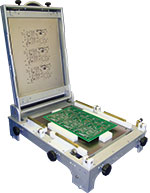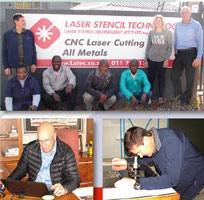

Since its inception in 2004, Laser Stencil Technology has grown into a prominent figure in the South African electronics manufacturing industry. Having been involved in circuit board manufacturing using the same photographic and etching technology since 1983, things changed for the company’s founder, Donovan Jeffery, when the first brass SMT stencil was produced and bonded directly to a steel frame. This led to the birth of Stencils CC in 1989, which ran concurrently with his involvement in PCB manufacturing, and ultimately, to the formation of Laser Stecil Technology (LST) in 2002.
Over time, stencil durability became an issue and brass was replaced with stainless steel, and by then the stencils were being bonded onto frames stretched with polyester mesh. This manufacturing method began to show its limitations around 2002 as technology became more advanced and customers began to express their need for smaller and more precise apertures. It was at this point that the inevitable decision had to be taken to purchase a stencil laser, and so the search began to find the best machine for the job. Together with the procurement of the new equipment, a new company was formed and Laser Stencil Technology (LST) was born.

In 2005, the company became the sole agent for Zelflex pneumatic frames, which proved to be substantially more cost effective for its customers by eliminating the aluminium frame, mesh and bonding costs. What is more, a stencil could now be engineered, cut and delivered within hours of the order being placed.
LST purchased the distribution licence for Vectorguard Stencil Foils in South Africa in 2010, giving its customers the choice of two systems to meet their specific assembly requirements. In the same year, a second stencil laser was purchased to improve production time during peak demand, as well as to provide redundancy in the event of downtime on the first laser.
July 2015 saw the company move into its own building in Strijdom Park, one of the busiest industrial centres in Johannesburg and conveniently positioned with easy access from the highway.
“As we know in this industry, nothing stands still, and in recent years new technology has presented many challenges to the assembly industry,” Jeffery muses. “There are occasions where PCB designs contain a large variety of parts including fine-pitch devices that require a thinner stencil and larger parts that require a thicker stencil. In this case it is possible for a multilevel or ‘stepped’ stencil to be designed and manufactured on our recently acquired laser which is unsurpassed in terms of capability and accuracy.”

Step-up areas are created by adding material to the stencil and are used to increase the volume and height of the solder paste in selected areas – useful for ‘pin in paste’ and large format devices. Step-down areas are created by removing material from the stencil and are used to reduce the volume and height of the solder paste deposit in selected areas. The multilevel stencil enables one to deposit the correct volume of paste for every device and therefore achieve optimum results.
“In June 2019, Laser Stencil Technology celebrated its 15th year of serving the South African electronics industry with an uncompromising attitude towards service and quality. One thing is certain, and that is that we could not have achieved what we have done without the loyal and unwavering support of our customers,” Jeffery concludes.
| Tel: | +27 11 793 1318 |
| Email: | [email protected] |
| www: | www.lstec.co.za |
| Articles: | More information and articles about Laser Stencil Technology |

© Technews Publishing (Pty) Ltd | All Rights Reserved